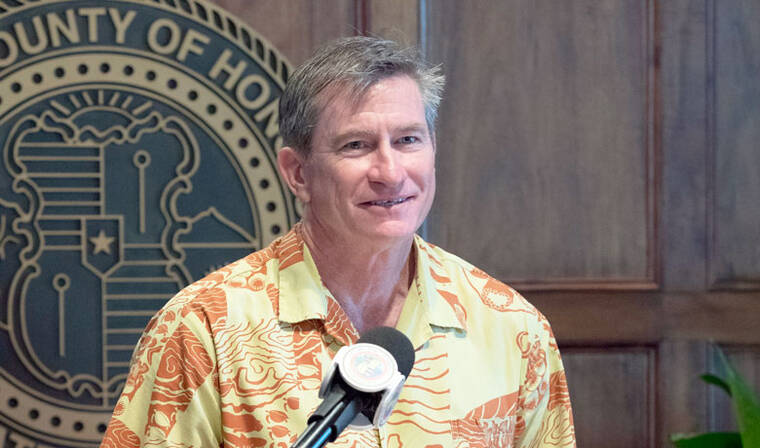Council calls for more Red Hill water testing

STAR-ADVERTISER
City Council Chairperson Tommy Waters
Due to the massive 2021 fuel spills linked to the Red Hill Bulk Fuel Storage Facility, which sickened families, fears over further contamination of Oahu’s groundwater supply have prompted the Honolulu City Council to take greater action on the matter.
At its meeting today, Council Chair Tommy Waters and Vice Chair Esther Kia‘aina are expected to introduce Resolution 216, which urges the U.S. Navy and Department of Defense to immediately implement weekly testing of all 36 of the Navy Red Hill monitoring wells and drinking water wells for all chemical contaminants stemming from past fuel and hazardous materials that were used, stored or released at the Red Hill facility.
“Through Resolution (216), the Council calls for real-time transparency to monitor the aquifer under Red Hill so the Board of Water Supply can proactively plan and take further action to protect the residents of Oahu,” a news release issued Tuesday by Council staff states.
It further notes that the Honolulu Board of Water Supply detected polycyclic aromatic hydrocarbons at its closed Aiea Wells in water samples collected in May and June.
PAHs, a class of chemicals that occur naturally in coal and petroleum products like crude oil and gasoline, are known to cause cancer, respiratory issues and other health effects, according to Council staff. The types of PAHs detected at the BWS Aiea Wells were also detected at the Navy’s monitoring well, NMW 24, in samples collected in June, indicating a contaminant plume may be migrating west of the Red Hill Fuel Facility.
Council staff also cite the inadequacy of the Navy’s Joint Base Pearl Harbor-Hickam Safe Waters website regarding monitoring wells.
Don't miss out on what's happening!
Stay in touch with breaking news, as it happens, conveniently in your email inbox. It's FREE!
“Samplers are able to draw from the well using a slow flow pump to collect samples each week,” but it reports only biweekly or twice a month, the staffers note.
This, according to Council staff, limits the City and County of Honolulu’s ability to understand, plan and respond to the contamination of Oahu’s freshwater supply.
Besides weekly testing, Resolution 216 also calls for the installation of additional monitoring wells in the west and northwest direction beyond the Red Hill Fuel Facility, and sending the unredacted laboratory reports to the BWS and the public.
The Navy, and its group responsible for shutting down the Red Hill fuel facility following the 2021 spills, responded to the Council’s resolution.
“Navy Closure Task Force — Red Hill is aware of the Honolulu City Council’s proposed resolution and we look forward to working with our regulators and stakeholders on current and future actions regarding the long-term environmental assessment and remediation of the Red Hill Bulk Fuel Storage Facility and surrounding areas,” a Navy spokesperson told the Honolulu Star-Advertiser via email Tuesday.
“Contrary to the Honolulu Board of Water Supply claims, the Navy has coordinated with the Hawaii Department of Health and Environmental Protection Agency to execute a robust and comprehensive groundwater sampling and testing program,” the spokesperson said. “At the start of defueling, the Navy increased to bi-weekly sampling of its network of more than 40 groundwater monitoring wells in and around the Red Hill facility in coordination with the DOH and EPA. To date, this extensive sampling indicates the contamination continues to be isolated directly underneath the Red Hill tank gallery.
“Sample results from our extensive and robust sampling program at Red Hill consistently shows the Navy’s drinking water continues to comply with all federal and state drinking water requirements and no contamination is moving from Red Hill,” the spokesperson said. “As a drinking water provider, the health, safety, and well-being of our community is important to the Navy.”
Waters disagreed.
“The U.S. Navy’s slow and inadequate response to reporting the aquifer contamination following the initial and devastating fuel leak into our water supply at Red Hill was unacceptable,” Waters said Tuesday in a written statement. “We must fully understand if fuel and other contaminants from the Red Hill facility are making their way to our other water sources.”
He added that “real-time monitoring and reporting are crucial to understanding the underground situation and protecting public health.”
“The Board of Water Supply is making efforts but needs access to the Navy’s well data immediately,” Waters added. “This testing and the resulting data are non-negotiable for us at this point.”
Ernie Lau, BWS manager and chief engineer, added that protecting Oahu’s fresh drinking water supply is paramount.
“We cannot stand by and not insist that the Navy step forward and start weekly testing for TPH and PFAS chemicals,” Lau said Tuesday in a written statement. “This must be done by an independent third-party contractor. This is our only water source, and it is our kuleana to keep it safe for future generations.”
Still, the Navy spokesperson asserted that “as per our annual consumer confidence reports, the compliance sampling for lead in JBPHH’s water distribution system continues to meet state and federal standards and the water remains safe for consumption.”
“In addition to ongoing compliance monitoring, the Navy conducts supplemental, enhanced drinking water monitoring across the JBPHH distribution system, utilizing EPA-approved sampling protocols to screen for numerous analytes, including lead. The Navy’s 2024 annual water quality report with the annual compliance information is posted for the public to review at 2024 Water Quality Report JBPHH.pdf,” the spokesperson said. “The Navy is proud of the extensive sampling programs we are conducting to protect the public safety and safeguard Oahu’s public drinking water supply.”
The Navy also rebutted BWS’ level of engagement in the monitoring process.
“Since Oct. 4, 2022, the Navy invited BWS on several occasions to collaborate and provide inputs to groundwater monitoring well locations and the draft Extended Drinking Water Monitoring Program that would mutually benefit our organizations and the community. The Navy has asked BWS to share which groundwater monitoring flow models they ascribe to, which would allow all of us to have continuous improvement on the scientific data,” the spokesperson said. “To date, BWS has not responded.”
The Council’s meeting begins at 10 a.m. inside City Council chambers.





